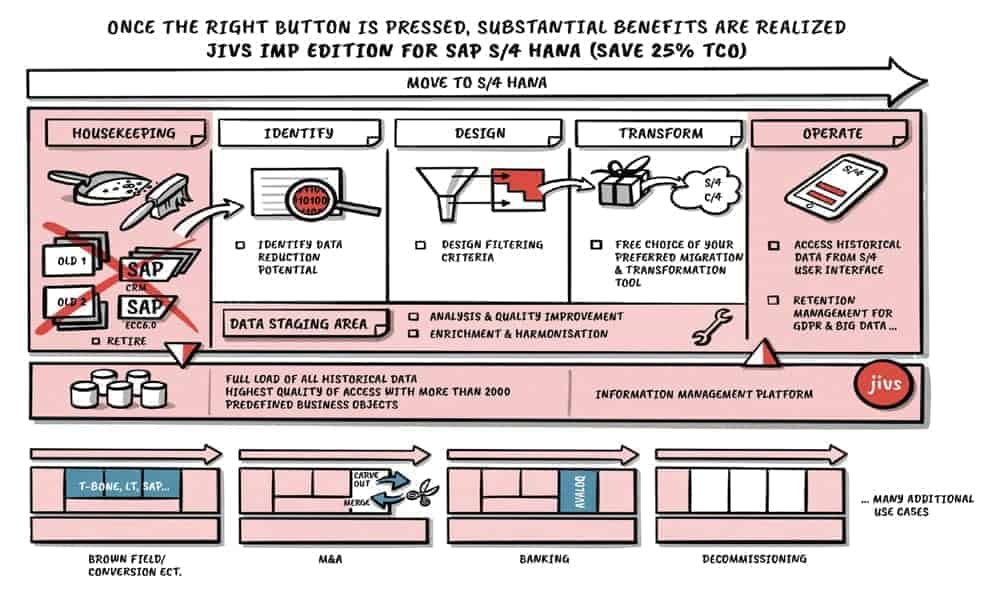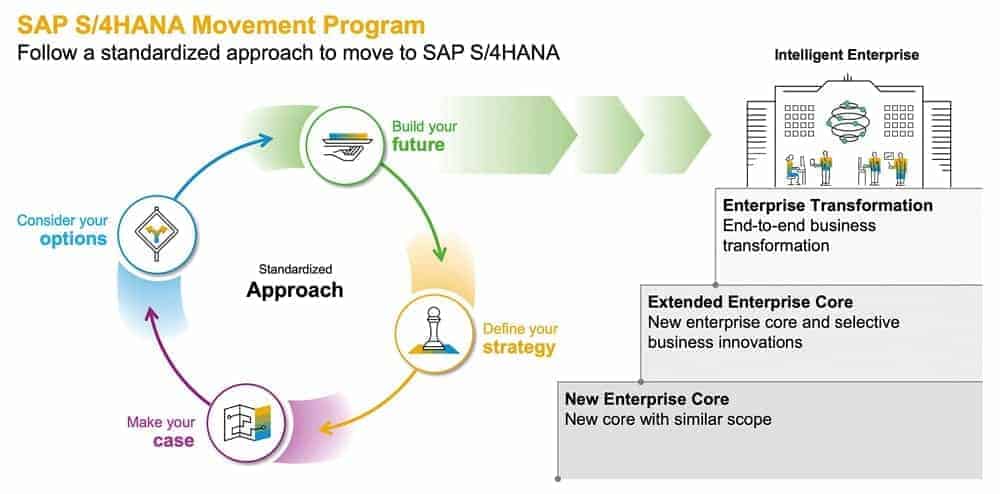Data - fuel or ballast?


The switch to S/4 Hana is about far more than just technology. The new software generation is the key to the long-term success of companies.
In order to master the challenges of digitalization, manage the exponentially increasing masses of data and implement new, data-supported and data-driven business models and processes, they need an intelligent ERP as the core of their IT landscape.
Although the introduction of a new generation of software and the corresponding migration and transformation project has many technical aspects, it is primarily of a strategic and organizational nature.
The planning and decision for a migration method, the specific design of the target landscape, the processes and scenarios supported by it and the handling of data and documents from the legacy systems determine the role and significance of the future IT environment for the business and the corporate strategy.
Mapping Your Journey
Or, as the guide "Mapping Your Journey to SAP S/4 Hana" succinctly puts it: "[...] the way you prepare and execute the project will determine whether you can turn SAP's innovations into an advantage for your business [...] whether your new system will deliver the business agility and speed to leave the competition behind with fully automated business processes."
SAP has launched the SAP S/4 Hana Movement program under the leadership of Bjoern Braemer to bring movement into this situation and provide practical guidance for customers.

As a guide through the planning and project jungle, it offers conceptual guidelines, practical tips, helpful tools and numerous services.
Regardless of the specific customer situation, Move defines four main phases on the path to S/4:
The first phase focuses on strategy development and formulation. Formats such as the "Move in Motion" series of events for the cross-industry exchange of ideas and experiences, a card game that shows the value creation potential of S/4 for various business areas and industries, simulations that help customers play through various decisions and their consequences, and workshops on a wide range of topics provide support.
They give customers a concrete impression of the potential they can tap into for their companies and the strategic issues they need to clarify:
Whether the existing business processes can support the corporate strategy in the long term or whether they should be further developed and mapped in S/4, whether the consolidation of the IT landscape and process harmonization are part of the project objectives and whether all or only some of the transaction data should be transferred to the new system.
In order for decision-makers inside and outside IT to determine the right strategy for their company, they need to familiarize themselves with the importance of data for the future and the scenarios based on it, as well as the most important technical principles.
The Internet of Things, big data and the separation of historical and operational data are relevant topics in this context. This is because decisions on the migration path and implementation method, process design and management of legacy information depend directly on the relevant knowledge. Ultimately, the intelligent company needs both intelligent ERP and intelligent data management.
Readiness and transformation
The answers to the strategic questions are provided in the second phase, the concrete development of the business case. This phase serves to coordinate business and IT so that everyone pulls in the same direction and the strategic goals are achieved.
Tools such as the SAP Readiness Check and the SAP Transformation Navigator or an online recommendation service, which determines the performance of existing processes and the value creation potential they contain, help with this.
It is equally important to use suitable tools to identify the information from the data and documents that will no longer be needed in operations after the switch to S/4.
In addition to the coordination between business and IT, this also involves determining the migration costs and the associated expenses.
The costs are not only influenced by the choice of implementation approach - system conversion versus new implementation or a mix of both in various gradations. Rather, their level also depends on the decision as to whether all or only parts of the data stock are transferred to S/4.
Consider Your Options
The third phase, which SAP calls "Consider Your Options", involves clarifying which of these options will be used in a specific case. If only parts of the information inventory are transferred to the new environment, the appropriate tools can be used to reduce the migration effort and shorten the duration of the system interruption during the changeover.
Build Your Future
The fourth phase is called "Build Your Future" and closes the circle, so to speak; it also leads to a continuous optimization cycle. After all, the implementation of S/4 can only be the basis for the future - albeit an innovative and intelligent basis for answering the following questions:
Have all migration and transformation goals been achieved? Can the processes be flexibly adapted to changes and further developments in the market and the corporate strategy?
Is IT able to extract information and insights from data that can drive the business forward and open up new value creation potential - right up to the introduction of a new business model? Can the landscape support agile scenarios such as mergers and acquisitions quickly and flexibly?
Will the data that has been transferred remain the fuel of digital business models in the long term or will it become ballast over time, impairing the agility that has just been gained and devouring growing resources?
Does the new landscape contribute to a lasting reduction in IT operating costs, leaving more investment funds for innovation not only in the short term, but also in the long term?
These questions must always be answered anew. The four Move phases can therefore serve as guidelines for the maintenance and further development of the S/4 environment, not only before and during the introduction, but also in the long term.
Whichever migration approach the customer ultimately chooses, whether system conversion, new implementation or selective data transfer and transformation, the existing legacy data and documents always play a decisive role in the considerations and measures. SAP therefore recommends clarifying the scope of the data migration "as early as possible".

Agility versus data inertia
This applies not only to the migration to S/4 itself. After all, companies are operating in an extremely dynamic environment, which in many industries gives current business initiatives a higher priority than the introduction of a new software generation. Business priorities therefore have a direct influence on IT priorities and require their adaptation and further development.
All of these sometimes conflicting goals and priorities relevant to phases one and two of the Move program must be considered simultaneously, and this against the backdrop that IT budgets are generally only increasing moderately, if at all. As a result, companies need to find ways to reduce the proportion of operational expenditure in IT.
The distinction that SAP makes in its guide to S/4 migration between open processes and the associated operational data on the one hand and historical data on the other points the way forward. The document states: "Like the pilot of a racing car, you need to know when data is fuel and when it is ballast."
Historical data
Historical data is defined as completed transactional data such as completed and fully paid sales or maintenance orders and purchase orders. It also includes documents such as delivery bills, even if they only relate to partial deliveries, i.e. the order itself has not yet been completed.
This historical data may no longer be changed for legal reasons. However, if users are only allowed to access it with read-only rights, it no longer always makes sense to transfer it to the new software landscape for various reasons.
Historical data therefore exhibits a certain inertia. Migration to S/4 with complete or partial data transfer, agile business scenarios, permanent reduction of operating costs - in all these cases, the prescribed immutability of historical data leads directly to the question of what should be done with the legacy systems.
This is because their continued operation incurs costs as long as the historical data has to be stored in an audit-proof manner. And since this storage must take place together with the business context in which the data was created, traditional data archives are not sufficient for this task.
Inertia and legacy systems
The question of how to deal with legacy systems also arises regardless of the migration path chosen, as the challenge of data inertia always exists.
In addition, the approach of selective data transfer threatens to increase project costs when migrating to S/4. SAP rightly emphasizes this in the migration guide mentioned above - unless the historical data can be extracted from the legacy systems and stored and accessed in a more cost-effective environment in a legally compliant manner.
This is because the legacy systems can then be completely decommissioned - an option that expands the scope for decision-making, especially in phase three. Experience shows that this usually reduces operating costs by 80 percent compared to continuing to operate the legacy systems.
These savings must be offset against the additional effort required for data selection during the migration to S/4. This additional effort can even be turned into a net saving. The prerequisite is the largely automated transfer of data from the legacy systems.
In addition, the filter rules for importing the selected data from the open processes must be created and transferred in a format that the SAP Migration Cockpit understands without errors and that is compatible with the vendor group's tools called "SAP S/4 Hana Selective Data Transition Engagement". If the prerequisites are met, the data migration effort can be reduced by up to half.
However, these savings in operational and migration costs are only one advantage of system decommissioning. The approach of outsourcing historical data to a separate environment also supports the agile application and business scenarios mentioned alongside migration.
Consolidation and harmonization projects for applications and locations can be significantly accelerated and simplified as a result. With this approach, IT can also handle acquisitions and sales faster and more cost-effectively, as it can decommission the systems and third-party solutions taken over during the purchase and remove the data to be transferred to a buyer from the database more quickly and transfer it in a neutral format.
In addition, a separate environment for historical data is able to make an important contribution to optimizing data quality and ensuring that only cleansed and complete data is transferred to the new environments.
A separate environment for historical data also ensures legal certainty if the information stored in it is subject to end-to-end retention management through to legally compliant deletion. This makes the requirements of the EU GDPR less daunting, especially for historical data.
Finally, such an environment can also be designed as part of the new system environment with S/4 at its core. If historical data is continuously and automatically outsourced, the operational systems remain permanently lean, which can be expected to have a noticeable and positive impact on the total cost of ownership.
In addition, the historical data remains 100 percent accessible and thus provides an all-round view of business information and its history, for example on customers and suppliers, which in turn enables better and even new insights for the business.
Fuel for continuous optimization
The solution described for selective data transfer as part of migration projects to SAP S/4 Hana supports all phases of the Move program.
In addition, the benefits that can be achieved are not a one-off effect, but can be integrated into a continuous optimization cycle.
This approach and the corresponding platform for information management, JiVS IMP, have already proven themselves in over 1000 projects worldwide. The latest generation of the platform, certified by auditors, is available in special SAP editions that complement and support the Move program in all its phases in a technically and commercially meaningful way. This means that historical data is never ballast, but always fuel.





